Piece of Art Work Held in Guggenheim New York
| | |
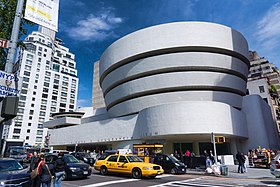 View from Fifth Avenue | |
 | |
| Established | 1937 |
|---|---|
| Location | 1071 5th Avenue at 89th Street Manhattan, New York Metropolis |
| Coordinates | 40°46′59″N 73°57′32″W / forty.78306°N 73.95889°Due west / forty.78306; -73.95889 Coordinates: twoscore°46′59″Northward 73°57′32″W / 40.78306°N 73.95889°W / 40.78306; -73.95889 |
| Blazon | Art museum |
| Visitors | 953,925 (2016)[1] |
| Director | Richard Armstrong |
| Public transit access | Subway: Coach: M1, M2, M3, M4, M86 SBS |
| Website | www |
| Built | 1956–1959 |
| Architect | Frank Lloyd Wright |
| Architectural style(s) | Modern |
| UNESCO World Heritage Site | |
| Criteria | Cultural: (ii) |
| Designated | 2019 (43rd session) |
| Part of | The 20th-Century Architecture of Frank Lloyd Wright |
| Reference no. | 1496-008 |
| Country Political party | United States |
| Region | Europe and North America |
| U.S. National Register of Historic Places | |
| Designated | May xix, 2005 (2005-05-19) [ii] |
| Reference no. | 05000443[ii] |
| U.S. National Historic Landmark | |
| Designated | October 6, 2008 (2008-ten-06) [3] |
| New York City Landmark | |
| Designated | August 14, 1990 (1990-08-14) [four] [5] |
| Reference no. | 1774 (exterior), 1775 (interior) |
The Solomon R. Guggenheim Museum, often referred to as The Guggenheim, is an fine art museum at 1071 5th Artery on the corner of Eastward 89th Street on the Upper East Side of Manhattan in New York Metropolis. Information technology is the permanent home of a continuously expanding collection of Impressionist, Postal service-Impressionist, early on Mod, and contemporary fine art and also features special exhibitions throughout the year. The museum was established by the Solomon R. Guggenheim Foundation in 1939 as the Museum of Non-Objective Painting, under the guidance of its first director, Hilla von Rebay. It adopted its current name in 1952, three years after the expiry of its founder Solomon R. Guggenheim.
In 1959, the museum moved from rented space to its current building, a landmark work of 20th-century architecture designed by Frank Lloyd Wright. The cylindrical building, wider at the top than at the lesser, was conceived as a "temple of the spirit". Its unique ramp gallery extends up from ground level in a long, continuous spiral along the outer edges of the building to end just under the ceiling skylight. The edifice underwent extensive expansion and renovations in 1992 when an adjoining tower was congenital, and from 2005 to 2008.
The museum'due south collection has grown over eight decades and is founded upon several important private collections, outset with that of Solomon R. Guggenheim. The drove is shared with sis museums in Bilbao, Spain and elsewhere. In 2013, well-nigh 1.two million people visited the museum, and it hosted the most pop exhibition in New York City.[six]
History [edit]
Early years and Hilla Rebay [edit]
Solomon R. Guggenheim, a member of a wealthy mining family unit, had been collecting works of the old masters since the 1890s. In 1926, he met creative person Hilla von Rebay,[7] who introduced him to European avant-garde art, in detail abstruse art that she felt had a spiritual and utopian aspect (non-objective art).[7] Guggenheim completely inverse his collecting strategy, turning to the work of Wassily Kandinsky, among others. He began to display his collection to the public at his apartment in the Plaza Hotel in New York City.[seven] [8] Every bit the collection grew, he established the Solomon R. Guggenheim Foundation, in 1937, to foster the appreciation of modernistic art.[8]
The Museum of Not-Objective Painting [edit]

The foundation'due south first venue for the brandish of art, the "Museum of Non-Objective Painting", opened in 1939 under the management of Rebay, in midtown Manhattan.[9] Under Rebay's guidance, Guggenheim sought to include in the collection the nearly of import examples of non-objective fine art bachelor at the time by early on modernists such every bit Rudolf Bauer, Rebay, Kandinsky, Piet Mondrian, Marc Chagall, Robert Delaunay, Fernand Léger, Amedeo Modigliani and Pablo Picasso.[seven] [8] [10]
By the early on 1940s, the foundation had accumulated such a big collection of avant-garde paintings that the need for a permanent museum building had get credible.[eleven] In 1943, Rebay and Guggenheim wrote a alphabetic character to Frank Lloyd Wright request him to design a construction to house and brandish the collection.[12] Wright accepted the opportunity to experiment with his organic style in an urban setting. It took him xv years, 700 sketches, and six sets of working drawings to create the museum.[13]
In 1948, the drove was greatly expanded through the buy of art dealer Karl Nierendorf'southward manor of some 730 objects, notably High german expressionist paintings.[10] By that time, the foundation's drove included a wide spectrum of expressionist and surrealist works, including paintings by Paul Klee, Oskar Kokoschka and Joan Miró.[x] [fourteen] After Guggenheim's death in 1949, members of the Guggenheim family who saturday on the foundation'due south board of directors had personal and philosophical differences with Rebay, and in 1952 she resigned as director of the museum.[15] Withal, she left a portion of her personal collection to the foundation in her will, including works by Kandinsky, Klee, Alexander Calder, Albert Gleizes, Mondrian and Kurt Schwitters.[14] The museum was renamed the Solomon R. Guggenheim Museum in 1952.[xv]
Design [edit]
Rebay conceived of the infinite as a "temple of the spirit" that would facilitate a new mode of looking at the modern pieces in the collection. She wrote to Wright that "each of these slap-up masterpieces should be organized into space, and only y'all ... would test the possibilities to exercise so. ... I want a temple of spirit, a monument!"[xvi] [17] The critic Paul Goldberger later on wrote that, before Wright's modernist building, "there were merely two mutual models for museum blueprint: Beaux-arts Palace ... and the International Style Pavilion."[18] Goldberger idea the building a catalyst for alter, making it "socially and culturally acceptable for an architect to blueprint a highly expressive, intensely personal museum. In this sense almost every museum of our time is a kid of the Guggenheim."[18]
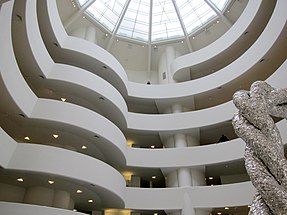
From 1943 to early 1944, Wright produced four unlike sketches for the initial design. While one of the plans (scheme C) had a hexagonal shape and level floors for the galleries, all the others had circular schemes and used a ramp standing around the building. He had experimented with the ramp pattern in 1948 at the Five. C. Morris Souvenir Store in San Francisco and on the house he completed for his son in 1952, the David and Gladys Wright House in Arizona.[19] Wright's original concept was chosen an inverted "ziggurat", because information technology resembled the steep steps on the ziggurats built in ancient Mesopotamia.[twenty] His pattern dispensed with the conventional arroyo to museum layout, in which visitors are led through a series of interconnected rooms and forced to retrace their steps when exiting.[21] Wright'southward plan was for the museum guests to ride to the meridian of the building by elevator, to descend at a leisurely footstep along the gentle slope of the continuous ramp, and to view the atrium of the building as the last work of art. The open up rotunda afforded viewers the unique possibility of seeing several bays of piece of work on different levels simultaneously and fifty-fifty to collaborate with guests on other levels.[22]
At the same time, before settling on the site for the museum at the corner of 89th Street and the Museum Mile department of Fifth Avenue, overlooking Central Park, Wright, Rebay and Guggenheim considered numerous locations in Manhattan, as well as in the Riverdale section of the Bronx, overlooking the Hudson River.[23] Guggenheim felt that the site's proximity to Central Park was important; the park afforded relief from the dissonance, congestion and concrete of the city.[20] Nature besides provided the museum with inspiration.[23] The edifice embodies Wright's attempts "to render the inherent plasticity of organic forms in compages".[21] The Guggenheim was to be the only museum designed by Wright. The urban center location required Wright to design the building in a vertical rather than a horizontal course, far different from his earlier, rural works.[twenty] [24]
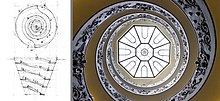
The spiral design recalled a nautilus shell, with continuous spaces flowing freely one into another.[25] Even as information technology embraced nature, Wright's design too expresses his have on modernist architecture's rigid geometry.[25] Wright ascribed a symbolic meaning to the edifice'southward shapes. He explained, "these geometric forms suggest certain man ideas, moods, sentiments – as for example: the circumvolve, infinity; the triangle, structural unity; the spiral, organic progress; the square, integrity."[26] Forms echo 1 another throughout: oval-shaped columns, for instance, reiterate the geometry of the fountain. Circularity is the leitmotif, from the rotunda to the inlaid design of the terrazzo floors.[23] Several architecture professors take speculated that the helical ramp and glass dome of Giuseppe Momo's 1932 staircase at the Vatican Museums was an inspiration for Wright's ramp and atrium.[27] [28] [29] Jaroslav Josef Polívka assisted Wright with the structural design and managed to design the gallery ramp without perimeter columns.[30]
The Guggenheim's surface was made out of concrete to reduce the cost, inferior to the stone terminate that Wright had wanted.[31] Wright proposed a ruby-colored exterior, which was never realized.[32] The modest rotunda (or "Monitor edifice", as Wright called it) next to the large rotunda was intended to house apartments for Rebay and Guggenheim but instead became offices and storage space.[33] In 1965, the second floor of the Monitor building was renovated to display the museum'south growing permanent drove, and with the restoration of the museum in 1990–92, it was turned over entirely to exhibition infinite and christened the Thannhauser Edifice, in accolade of one of the nigh important bequests to the museum.[34] Wright's original plan for an adjoining belfry, artists' studios and apartments went unrealized, largely for financial reasons, until the renovation and expansion.[22] [35] Also in the original structure, the master gallery skylight had been covered, which compromised Wright's carefully articulated lighting effects. This changed in 1992 when the skylight was restored to its original design.[31]
Sweeney years and completion of construction [edit]
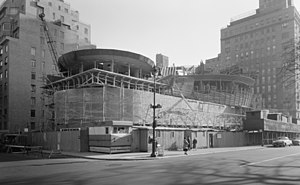
Museum under construction in photo taken on Nov 12, 1957
In 1953, the foundation'south collecting criteria expanded under its new director, James Johnson Sweeney. Sweeney rejected Rebay'southward dismissal of "objective" painting and sculpture, and he soon caused Constantin Brâncuși's Adam and Eve (1921), followed past works of other modernist sculptors, including Joseph Csaky, Jean Arp, Calder, Alberto Giacometti and David Smith.[10] Sweeney reached beyond the 20th century to acquire Paul Cézanne'due south Man with Crossed Arms (c. 1899).[10] The same year, the foundation also received a souvenir of 28 important works from the Estate of Katherine S. Dreier, a founder of America'southward first drove to be chosen a mod art museum, the Société Anonyme. Dreier had been a colleague of Rebay'southward. The works included Little French Daughter (1914–18) by Brâncuși, an untitled still life (1916) by Juan Gris, a statuary sculpture (1919) by Alexander Archipenko and three collages (1919–21) by German language Hanoverian Dadaist Schwitters. Information technology also included works by Calder, Marcel Duchamp, El Lissitzky and Mondrian.[14] Among others, Sweeney also acquired the works of Alberto Giacometti, David Hayes, Willem de Kooning and Jackson Pollock.[36]
Sweeney oversaw the final half dozen years of the construction of the museum building, during which time he had an antagonistic relationship with Frank Lloyd Wright, particularly regarding the building's lighting issues.[37] [38] The distinctive cylindrical building turned out to be Wright's last major work, equally the builder died six months before its opening.[39] From the street, the building looks similar a white ribbon curled into a cylindrical stack, wider at the pinnacle than the lesser, displaying almost all curved surfaces. Its advent is in abrupt dissimilarity to the typically rectangular Manhattan buildings that surround it, a fact relished by Wright, who claimed that his museum would make the nearby Metropolitan Museum of Art "await like a Protestant befouled".[39] Internally, the viewing gallery forms a helical spiral ramp climbing gently from ground level to the skylight at the summit.[39]
Critique and opening of the building [edit]
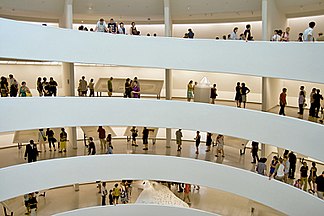
An interior view of the museum on a busy day
Fifty-fifty before it opened, the design polarized architecture critics.[39] [40] Some believed that the building would overshadow the museum's artworks.[41] [42] "On the opposite", wrote the builder, the design makes "the edifice and the painting an uninterrupted, cute symphony such every bit never existed in the Earth of Art before."[41] Other critics, and many artists, felt that it is bad-mannered to properly hang paintings in the shallow, windowless, concave exhibition niches that environs the primal spiral.[39] Prior to the opening of the museum xx-ane artists signed a alphabetic character protesting the display of their work in such a space.[39] Historian Lewis Mumford summed up the opprobrium:
Wright has allotted the paintings and sculptures on view only as much space as would not infringe upon his abstract limerick. ... [He] created a beat out whose form has no relation to its function and offered no possibility of future difference from his rigid preconceptions. [The promenade] has, for a museum, a low ceiling – 9 anxiety eight inches [295 cm] [limiting painting size. The wall] slanted outward, following the outward slant of the outside wall, and paintings were not supposed to be hung vertically or shown in their true plane but were to be tilted dorsum against it. ... Nor [can a visitor] escape the lite shining in his eyes from the narrow slots in the wall.[43]
On Oct 21, 1959, 10 years afterward the expiry of Solomon Guggenheim and six months after the death of Frank Lloyd Wright, the Museum first opened its doors to large crowds.[44] [11] The building became widely praised[45] [46] [47] and inspired many other architects.[20]

The skylight in the eye of the museum
Messer years [edit]
Thomas Grand. Messer succeeded Sweeney as managing director of the museum (only not the foundation) in 1961 and stayed for 27 years, the longest tenure of any of the urban center's major arts institutions' directors.[48] When Messer took over, the museum's ability to present art at all was still in uncertainty due to the challenges presented by continuous screw ramp gallery that is both tilted and has non-vertical curved walls.[49] It is difficult to properly hang paintings in the shallow, windowless exhibition niches that surround the key spiral: canvasses must be mounted raised from the wall's surface. Paintings hung slanted back would appear "as on the creative person'south easel". At that place is limited space within the niches for sculpture.[39]
Well-nigh immediately, in 1962, Messer took a risk putting on a large exhibition that combined the Guggenheim'southward paintings with sculptures on loan from the Hirshhorn drove.[49] Iii-dimensional sculpture, in particular, raised "the problem of installing such a show in a museum bearing then shut a resemblance to the circular geography of hell", where any vertical object appears tilted in a "drunken lurch" because the slope of the floor and the curvature of the walls could combine to produce vexing optical illusions.[50] Information technology turned out that the combination could work well in the Guggenheim'due south infinite, but, Messer recalled that at the time, "I was scared. I half felt that this would exist my final exhibition."[49] Messer had the foresight to gear up past staging a smaller sculpture exhibition the previous yr, in which he discovered how to compensate for the infinite's weird geometry past constructing special plinths at a particular angle, so the pieces were not at a true vertical yet appeared to exist and so.[50] In the earlier sculpture show, this trick proved impossible for one piece, an Alexander Calder mobile whose wire inevitably hung at a true plumb vertical, "suggesting hallucination" in the disorienting context of the tilted flooring.[l]
The next year, Messer acquired a private collection from art dealer Justin K. Thannhauser for the museum'south permanent drove.[51] These 73 works include Impressionist, Post-Impressionist and French mod masterpieces, including important works by Paul Gauguin, Édouard Manet, Camille Pissarro, Vincent van Gogh and 32 works by Pablo Picasso.[14] [52] "Works & Procedure" is a series of performances at the Guggenheim begun in 1984.[53] The first flavour consisted of Philip Glass with Christopher Keene on Akhnaten and Steve Reich and Michael Tilson Thomas on The Desert Music.
Krens and expansion [edit]
Thomas Krens, director of the foundation from 1988 to 2008, led a rapid expansion of the museum's collections.[54] In 1991, he broadened its holdings past acquiring the Panza Collection. Assembled by Count Giuseppe di Biumo and his wife, Giovanna, the Panza Drove includes examples of minimalist sculptures by Carl Andre, Dan Flavin and Donald Judd, and minimalist paintings by Robert Mangold, Brice Marden and Robert Ryman, equally well as an assortment of postminimal, conceptual, and perceptual art by Robert Morris, Richard Serra, James Turrell, Lawrence Weiner and others, notably American examples of the 1960s and 1970s.[fourteen] [55] In 1992, the Robert Mapplethorpe Foundation gifted 200 of his all-time photographs to the foundation. The works spanned his entire output, from his early collages, Polaroids, portraits of celebrities, self-portraits, male and female nudes, flowers and statues. It too featured mixed-media constructions and included his well-known 1998 Self-Portrait. The acquisition initiated the foundation's photography exhibition program.[fourteen]
Too in 1992, the New York museum building'due south exhibition and other infinite was expanded by the addition of an adjoining rectangular tower that stands behind, and taller than, the original screw, and a renovation of the original building.[35] The new tower was designed past the architectural firm of Gwathmey Siegel & Associates Architects,[56] who analyzed Wright'southward original sketches when they designed the 10-story limestone tower, which replaced a much smaller structure. Information technology has four additional exhibition galleries with flat walls that are "more appropriate for the display of art".[22] [35] In the original construction of the building, the main gallery skylight had been covered, which compromised Wright'south advisedly articulated lighting effects. This changed in 1992 when the skylight was restored to its original design.[31]

To finance these moves, controversially, the foundation sold works by Kandinsky, Chagall and Modigliani to enhance $47 meg, drawing considerable criticism for trading masters for "trendy" latecomers. In The New York Times, critic Michael Kimmelman wrote that the sales "stretched the accepted rules of deaccessioning further than many American institutions have been willing to practice."[31] [57] Krens defended the action every bit consistent with the museum's principles, including expanding its international collection and building its "postwar collection to the force of our pre-war holdings"[55] and pointed out that such sales are a regular practice by museums.[57] At the aforementioned time, he moved to aggrandize the foundation's international presence by opening museums abroad.[58] Krens was as well criticized for his businesslike fashion and perceived populism and commercialization.[59] [60] One writer commented, "Krens has been both praised and vilified for turning what was once a modest New York establishment into a worldwide brand, creating the kickoff truly multinational arts establishment. ... Krens transformed the Guggenheim into one of the all-time-known brand name in the arts."[61]
Under Krens, the museum mounted some of its most popular exhibitions: "Africa: The Art of a Continent" in 1996; "Prc: 5,000 Years" in 1998, "Brazil: Body & Soul" in 2001; and "The Aztec Empire" in 2004.[62] It has shown unusual exhibitions on occasion, for case commercial art installations of motorcycles. The New Criterion'due south Hilton Kramer condemned "The Fine art of the Motorcycle"[59] [63] A 2009 retrospective of Frank Lloyd Wright showcased the architect on the 50th anniversary of the opening of the building and was the museum's almost pop exhibit since it began keeping such attendance records in 1992.[64]

Students sketching at the entrance to the Sackler Center
In 2001, the museum opened the Sackler Center for Arts Education. The 8,200 square feet (760 mtwo) facility provides classes and lectures about the visual and performing arts and opportunities to interact with the museum'due south collections and special exhibitions through its labs, exhibition spaces, briefing rooms and 266-seat Peter B. Lewis Theater.[65] [66] It is located on the lower level of the museum, below the big rotunda and was a souvenir of the Mortimer D. Sackler family.[67] Too in 2001, the foundation received a gift of the large collection of the Bohen Foundation, which, for two decades, commissioned new works of art with an accent on film, video, photography and new media. Artists included in the drove are Pierre Huyghe and Sophie Calle.[7]
Outside restoration [edit]
Betwixt September 2005 and July 2008, the Guggenheim Museum underwent a pregnant exterior restoration to repair cracks and[68] modernize systems and outside details.[69] In the first phase of this project, a team of restoration architects, structural engineers, and architectural conservators worked together to create a comprehensive assessment of the building's condition that determined the structure to be fundamentally sound. This initial condition assessment included:
- the removal of paint from the original surface, revealing hundreds of cracks acquired over the years, primarily by seasonal temperature fluctuations;[68]
- detailed monitoring of the motility of selected cracks over 17 months;
- touch-repeat applied science, in which sound waves are sent into the concrete and the rebound is measured to locate voids within the walls;
- light amplification by stimulated emission of radiation surveys of the exterior and interior surfaces, believed to be the largest laser model e'er compiled;
- cadre drilling to assemble samples of the original physical and other structure materials; and
- testing of potential repair materials.[70]
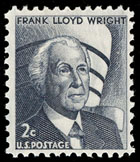
1966 two Cent U.S. postage stamp honoring Wright
Much of the interior of the edifice was restored during the 1992 renovation and addition by Gwathmey Siegel and Associates Architects. The 2005–2008 restoration primarily addressed the exterior of the original building and the infrastructure. This included the skylights, windows, doors, concrete and gunite facades and exterior sidewalk, as well as the climate-control. The goal was to preserve equally much meaning historical fabric of the museum as possible, while accomplishing necessary repairs and attaining a suitable environment for the edifice'southward continuing use as a museum.[71]
On September 22, 2008, the Guggenheim historic the completion of a three-yr restoration project. New York City Mayor Michael Bloomberg officiated at the celebration that culminated with the premiere of artist Jenny Holzer's tribute For the Guggenheim,[72] a work commissioned in honor of Peter B. Lewis, who was a major distributor in the Museum restoration project. Other supporters of the $29 one thousand thousand restoration included the Board of Trustees of the Solomon R. Guggenheim Foundation, and the city'south Department of Cultural Diplomacy. Additional support was provided past the Country of New York and MAPEI Corporation.[73]
Recent years [edit]

In 2005, Krens won a dispute with billionaire philanthropist Peter B. Lewis, chairman of the foundation's Board of Directors and the largest contributor to the foundation in its history. Lewis resigned from the Board, expressing opposition to Krens' plans for further global expansion of the Guggenheim museums.[74] Too in 2005, Lisa Dennison, a longtime Guggenheim curator, was appointed director of the Solomon R. Guggenheim Museum in New York. Dennison resigned in July 2007, to piece of work at the auction firm Sotheby's.[75] Tensions betwixt Krens and the Board continued, and in February 2008 Krens stepped down as the Director of the foundation, although he remains an counselor for international affairs.[76]
Richard Armstrong became the fifth director of the museum on November 4, 2008. He had been director of the Carnegie Museum of Art in Pittsburgh, Pennsylvania for 12 years, where he had as well served every bit master curator and curator of contemporary art.[77] The chief curator and deputy managing director of the museum is Nancy Spector.[78]
In add-on to its permanent collections, which continue to grow,[7] the foundation administers loan exhibitions and co-organizes exhibitions with other museums to foster public outreach.[79] In 2013, near 1.2 million people visited the museum, and its James Turrell exhibition was the most popular in New York City in terms of daily attendance.[6]
In 2019, Chaédria LaBouvier became the start black adult female curator to create a solo exhibition and start black person to write a text published past the museum.[80] [81] She accused the museum of racism afterward it refused to let her contribute to the audio guide for her exhibition and allegedly withheld resources from her and excluded her from a panel hosted virtually the bear witness. Within a calendar month after LaBouvier fabricated these criticisms, the museum hired its first full-time black curator, Ashley James.[82]
Landmark designations [edit]
On Baronial fourteen, 1990, the museum and its interior were separately designated equally New York Metropolis Landmarks.[four] [five] The museum was added to the National Register of Historic Places on May nineteen, 2005,[2] and was registered as a National Historic Landmark on October 6, 2008.[3] In July 2019, the Guggenheim was among eight properties by Wright placed on the World Heritage List nether the title "The 20th-Century Architecture of Frank Lloyd Wright".[83] [84] [85]
Selected works in the collection [edit]
-
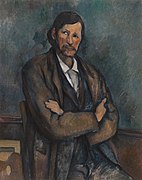
Paul Cézanne, c.1899, Homme aux bras croisés (Man With Crossed Arms), oil on sail, 92 ten 72.vii cm
-

Georges Braque, 1909, Violin and Palette (Violon et palette, Dans l'atelier), oil on canvas, 91.7 x 42.8 cm
-

Franz Marc, 1911, The Yellow Moo-cow, oil on canvas, 140.5 ten 189.two cm
-
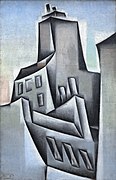
Juan Gris, 1911, Maisons à Paris (Houses in Paris), 1911, oil on sail, 52.iv x 34.2 cm
-
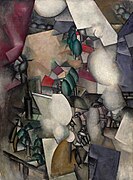
Fernand Léger, 1911–12, Les Fumeurs (The Smokers), oil on canvass, 129.2 x 96.5 cm
-

-

Fernand Léger, 1912–13, Nude Model in the Studio (Le modèle nu dans fifty'atelier), oil on burlap, 128.6 x 95.nine cm
-

Marc Chagall, 1913, Paris par la fenêtre (Paris Through the Window), oil on sheet, 136 x 141.nine cm
-

-

Juan Gris, 1917, Compotier et nappe à carreaux (Fruit Dish on a Checky Tablecloth), oil on wood panel, 80.half dozen x 53.nine cm
-

Paul Klee, 1922, Red Balloon (Roter Ballon) oil on chalk-primed gauze, mounted on board, 31.7 × 31.one cm
See likewise [edit]
- Listing of Frank Lloyd Wright works
- List of Guggenheim Museums
- List of New York Urban center Designated Landmarks in Manhattan from 59th to 110th Streets
- National Annals of Historic Places listings in Manhattan from 59th to 110th Streets
References [edit]
Citations [edit]
- ^ "Company figures 2016" (PDF). The Art Paper. April 2017. p. 14. Retrieved June 8, 2018.
- ^ a b c "National Register Information Organization". National Annals of Historic Places. National Park Service. March 13, 2009.
- ^ a b "National Register of Celebrated Places; New Listings October half-dozen – October 10, 2008", NPS.gov, October 17, 2008. Retrieved May 8, 2009.
- ^ a b "The Solomon R. Guggenheim Museum" (PDF). New York City Landmarks Preservation Committee. August xiv, 1990. Retrieved June eighteen, 2019.
- ^ a b "The Solomon R. Guggenheim Museum: Interior" (PDF). New York City Landmarks Preservation Commission. Baronial xiv, 1990. Retrieved June 18, 2019.
- ^ a b "Top 100 Art Museum Attendance", The Art Newspaper, 2014, pp. 11 and 15, accessed July eight, 2014.
- ^ a b c d e f "Exhibition of Works Reflecting the Evolution of the Guggenheim's Drove Opens in Bilbao", artdaily.org, 2009. Retrieved April xviii, 2012.
- ^ a b c "Biography: Solomon R. Guggenheim", Fine art of Tomorrow: Hilla Rebay and Solomon R. Guggenheim, Solomon R. Guggenheim Foundation. Retrieved March eight, 2012.
- ^ Vail 2009, pp. 25, 36.
- ^ a b c d east Calnek, Anthony, et al. The Guggenheim Drove, pp. 39–forty, New York: The Solomon R. Guggenheim Foundation, 2006
- ^ a b "Guggenheim Foundation History". Guggenheim. February 29, 2016. Retrieved October 21, 2019.
- ^ Vail 2009, p. 333.
- ^ "Guggenheim Compages". Archived from the original on May 1, 2016. Retrieved Baronial 13, 2016.
- ^ a b c d east f "Guggenheim Museum New York", Encyclopedia of Art, visual-arts-cork.com. Retrieved Apr 18, 2012.
- ^ a b "Biography: Hilla Rebay", Fine art of Tomorrow: Hilla Rebay and Solomon R. Guggenheim, Solomon R. Guggenheim Foundation. Retrieved March viii, 2012.
- ^ Levine 1996, p. 299.
- ^ The Guggenheim: Frank Lloyd Wright and the Making of the Mod Museum, pp. 217–18, New York: Guggenheim Museum Publications, 2009
- ^ a b "The Secret Life of Buildings: New York Public Library and Guggenheim Museum" [ permanent dead link ] , Colebrook Bosson Saunders Products Ltd.. Retrieved March 21, 2012.
- ^ Hitchcock, Henry-Russell (1981). Arquitectura de los siglos Xix y 20 (6th ed.). Madrid: Ediciones Cátedra. p. 477. ISBN9788437624464.
- ^ a b c d Storrer 2002, pp. 400–01
- ^ a b Levine 1996, p. 340.
- ^ a b c Perez, Adelyn. "AD Classics: Solomon R. Guggenheim Museum", May 18, 2010. Retrieved March 21, 2012.
- ^ a b c Ballon 2009, pp. 22–27
- ^ Since Wright was not licensed as an architect in New York, he relied on Arthur Cort Holden, of the architectural house Holden, McLaughlin & Assembly, to deal with New York Urban center'due south Board of Standards and Appeals. Dal Co, Francesco (2017). The Guggenheim: Frank Lloyd Wright'southward Iconoclastic Masterpiece. New Haven: Yale Academy Press. p. 58. ISBN978-0300226058. OCLC 969981835.
- ^ a b Levine 1996, p. 301.
- ^ Rudenstine, Angelica Zander. The Guggenheim Museum Collection: Paintings, 1880–1945, New York: Solomon R. Guggenheim Museum, 1976, p. 204
- ^ Tanzj, Daniela; Bentivegna, Andrea (July 23, 2015). "The Vatican Museums and the Guggenheim: Ii Ingenious Spirals of Art". La Voce di New York.
- ^ Hersey, George 50. (1993). High Renaissance art in St. Peter's and the Vatican: an interpretative guide. Chicago: University of Chicago Press. p. 128. ISBN9780226327822.
- ^ Mindel, Lee F. (February 28, 2013). "Compares the Oculi at the Vatican and the Guggenheim Museum". Architectural Assimilate.
- ^ Jaroslav J. Polívka, "What it'southward Like to Work with Wright" in Tejada, Susana, ed. (2000). Engineering the Organic: The Partnership of Jaroslav J. Polivka and Frank Lloyd Wright. Buffalo: State University of New York. pp. 34–35.
- ^ a b c d Sennott 2004, pp. 572–73
- ^ Bianchini, Riccardo. "The Guggenheim, an American revolution", inexhibit.com, 2014, accessed July 5, 2014.
- ^ Levine 1996, p. 317.
- ^ Ballon 2009, pp. 59–61.
- ^ a b c Overview of firm'due south history, projects, etc. Gwathmey Siegel website
- ^ The Global Guggenheim, The Solomon R. Guggenheim Museum Publications. Retrieved March viii, 2012.
- ^ "James Johnson Sweeney records", Solomon R. Guggenheim Archives Collections. Retrieved March 8, 2012.
- ^ Glueck, Grace. "James Johnson Sweeney Dies; Fine art Critic and Museum Caput". The New York Times. April 15, 1986.
- ^ a b c d due east f g "Art: Last Monument". Fourth dimension. Nov ii, 1959.
- ^ "Controversial Museum Opens in New York", The News and Courier, October 22, 1959, p. ix-A.
- ^ a b "Oct 21, 1959: Guggenheim Museum opens in New York Urban center", This Solar day in History, History.com. Retrieved March 21, 2012.
- ^ Goldberger, Paul. "Spiralling Up", Celebrating l years of Frank Lloyd Wright'southward Guggenheim, The New Yorker, May 25, 2009. Retrieved March 21, 2012.
- ^ Mumford, Lewis "The Sky Line: What Wright Hath Wrought" (1959) in The Highway and the Urban center, New York: New American Library, 1964. pp. 141–142 (get-go published in The New Yorker, Dec 5, 1959)
- ^ Spector 2001, p. xvi.
- ^ "The Wright Stuff". United states Today (Weekend). Nov vi, 1998 [ dead link ]
- ^ Levine 1996, p. 362.
- ^ "The Solomon R. Guggenheim Museum", The Art Story Foundation. Retrieved March 21, 2012.
- ^ Kumar 2011, affiliate: "Thomas Messer".
- ^ a b c Russell, John. "Managing director of Guggenheim Retiring Afterwards 27 Years", The New York Times, November 5, 1987. Retrieved April fourteen, 2012.
- ^ a b c Canaday, John. "Museum Director Solves Trouble; Guggenheim Official Faces Troubles of Architecture", The New York Times, August 17, 1962
- ^ Decker, Andrew. "Oral History Interview with Thomas K. Messer, 1994 October. – 1995 January.", Archives of American Art, Jan 25, 1995. Retrieved March 13, 2012.
- ^ "Thannhauser, Justin K.: The Frick Drove", Archives Directory for the History of Collecting in America. Retrieved March thirteen, 2012.
- ^ "Works & Procedure". Archived from the original on December 6, 2008. Retrieved August 13, 2016.
- ^ Vogel, Carol. "Guggenheim's Provocative Director Steps Down", The New York Times, February 28, 2008. Retrieved March 8, 2012.
- ^ a b Glueck, Grace. "Guggenheim May Sell Artworks to Pay for a Major New Collection", The New York Times, March 5, 1990. Retrieved March thirteen, 2012.
- ^ Gwathmey Siegel web site: Overview of firm's history, projects, etc.
- ^ a b Kimmelman, Michael (Apr one, 1990), "Art View; The High Cost of Selling Art", The New York Times , retrieved April 9, 2012
- ^ Russell, James S. "Guggenheim'southward Krens Eyes Hudson Yards Museum, Seeks New Bilbaos", Bloomberg, March 11, 2008. Retrieved March xiii, 2012.
- ^ a b Sudjic, Deyan (Jan 23, 2005), "Is this the stop of the Guggenheim dream?", The Observer, London, UK: Guardian News and Media Limited
- ^ Gibson, Eric (November 27, 1998), "For Museums, Bigger Is Better", The Wall Street Journal
- ^ Mahoney, Sarah (October 2, 2006), "Thomas Krens", Advertising Age, vol. 77, no. 40, p. I-viii
- ^ Vogel, Carol. "A Museum Visionary Envisions More than", The New York Times, Apr 27, 2005. Retrieved February 2, 2011.
- ^ Plagens, Peter (September 7, 1998), "Rumble on the Ramps. ('The Art of the Motorbike', Solomon R. Guggenheim Museum, New York)", Newsweek, vol. 132, no. 10, p. 80
- ^ "Kandinsky Retrospective Helps Set New Attendance Tape for 2009". Guggenheim. January 25, 2010. Retrieved March 24, 2020.
- ^ "Sackler Center for Arts Education" Archived February nine, 2014, at the Wayback Auto, The Solomon R. Guggenheim Foundation. Retrieved March 21, 2012.
- ^ Tu, Jeni (February one, 2002). "Higher pedagogy meets high art". Trip the light fantastic toe Teacher. Archived from the original on September 21, 2014. Retrieved August 25, 2014 – via HighBeam Research.
- ^ Weber, Bruce (March 31, 2010). "Mortimer D. Sackler, Arts Patron, Dies at 93". The New York Times . Retrieved July 17, 2014. ; "Museum gets gift for arts instruction". Milwaukee Journal Sentinel. New York Times News Service. December 12, 1995. p. 2E. Retrieved August 22, 2014. ; and "Kim Kanatani Will Occupy Newly Created Gail Engelberg Chair in Education". The Solomon R. Guggenheim Foundation. Archived from the original (Printing release) on July 26, 2014. Retrieved July 17, 2014.
- ^ a b Park, Haeyoun. "Face-lift for an Aging Museum", The New York Times, April sixteen, 2007
- ^ Guggenheim Museum web site: click link to podcast nigh restoration (10 MB, audio merely, 8 min 45 sec)
- ^ Pogrebin, Robin. "The Restorers' Art of the Invisible", The New York Times, September x, 2007, pp. E1–5.
- ^ Guggenheim Museum web site: click link to podcast nearly restoration (x MB, sound but, 8 min 45 sec) Archived September 28, 2007, at the Wayback Machine
- ^ Villarreal, Ignacio. "Guggenheim Marks Completion of Restoration With First Public Viewing of Piece of work past Creative person Jenny Holzer", Artdaily.com. Retrieved May 8, 2009.
- ^ Guggenheim Museum spider web site: printing release almost restoration Archived June vi, 2014, at the Wayback Machine
- ^ Vogel, Ballad. "Guggenheim Loses Top Donor in Rift on Spending and Vision", Jan twenty, 2005, The New York Times'. Retrieved Dec 6, 2012.
- ^ Vogel, Carol. "Director of Guggenheim Resigns to Join Sotheby'due south". The New York Times. July 31, 2007.
- ^ Lewis, Carol. "Provocative Guggenheim director resigns", The New York Times, February 28, 2008, accessed October 21, 2011.
- ^ Vogel, Carol. "Guggenheim Chooses a Curator, Not a Showman", The New York Times, September 23, 2008. Retrieved March 14, 2012.
- ^ "25 Art World Women at the Top, From Sheikha Al-Mayassa to Yoko Ono", Artnet, April 17, 2014
- ^ Foundation website'due south collaborations folio Archived Apr 5, 2014, at the Wayback Machine
- ^ Mitter, Siddhartha (July xxx, 2019). "Backside Basquiat'south 'Defacement': Reframing a Tragedy". The New York Times. ISSN 0362-4331. Retrieved June 3, 2020.
- ^ "Chaédria LaBouvier". The Root. 2019. Retrieved June 3, 2020.
- ^ Greig, Jonathan (November 19, 2019). "Blavity News & Politics". Blavity News & Politics . Retrieved June 3, 2020.
- ^ "Guggenheim museum among viii buildings past Frank Lloyed wright inscribed on UNESCO world heritage list". TeRra Magazine.
- ^ "The 20th-Century Architecture of Frank Lloyd Wright". UNESCO World Heritage Centre. Retrieved July seven, 2019.
- ^ Tareen, Sophia (July 8, 2019). "Guggenheim Museum Added to UNESCO World Heritage List". NBC New York . Retrieved July eight, 2019.
Sources [edit]
- Ballon, Hillary; et al. (2009). The Guggenheim: Frank Lloyd Wright and the Making of the Modern Museum. London: Thames and Hudson.
- Kumar, Lisa (2011). The Writers Directory. Detroit: St. James Press. ISBN9781558628137.
- Levine, Neil (1996). The Architecture of Frank Lloyd Wright . New Jersey: Princeton Academy Press.
- Sennott, R. Stephen (2004). Encyclopedia of 20th-Century Architecture. Vol. 2. New York: Fitzroy Dearborn.
- Spector, Nancy, ed. (2001). Guggenheim Museum Collection: A to Z. New York: The Solomon R. Guggenheim Foundation.
- Storrer, William Allin (2002). The Compages of Frank Lloyd Wright: A Complete Catalogue. Chicago: University of Chicago Printing. , S.400
- Vail, Karole, ed. (2009). The Museum of Non-Objective Painting. New York: The Solomon R. Guggenheim Foundation.
External links [edit]
| External video | |
|---|---|
| |
- Official website

- Google Cultural Constitute page
Source: https://en.wikipedia.org/wiki/Solomon_R._Guggenheim_Museum
0 Response to "Piece of Art Work Held in Guggenheim New York"
إرسال تعليق